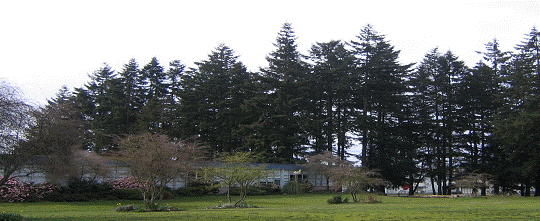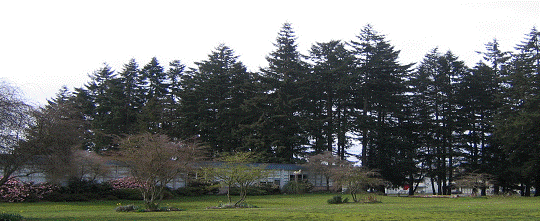It was a long shot expecting the City of Seattle to come to the defense of the old trees at Ingraham High School. The Seattle School District also only sawthe trees as an impediment to their development plans. Now Seattle Hearing Examiner Ann Watanabe has also chose to ignore the evidence in the Hearing Record and Seattle City law requiring that priority be given to protecting uncommon plant and animal habitat in the City of Seattle. She has denied the appeal by Save the Trees-Seattle to stop the 70 year old 100 foot tall eveegreen trees from being cut being cut down at Ingraham High School in North Seattle.
The decision is not yet posted on the Hearing Examiner’s website. When it is I will post a link here.
The environmental review now goes back to the King County Superior Court. We will be appealing the decision and it will be up to the court to make a final decision. They previously issued a restraining order preventing the Seattle School District from cutting down the 70 year old 100 foot tall Douglas fir, western red cedar and Pacific madrone trees until the environmental review was completed by the City of Seattle. That has now been done.
In her most recent decision Seattle hearing Examiner Ann Watanabe chose to ignore testimony from Save the Trees – Seattle that alternative sites for building the school addition were available on the Ingraham campus and that the Seattle School District padded the cost for other sites by adding in features like an additional 2000 square foot entrance on designs for the North side. Of course this raised the cost for any North side addition. The Seattle School District’s designs and cost estimates for alternative sites lacked credibility when closely examined.
Many of the issues raised were ignored by the Hearing Examiner. One obvious early sign of the Hearing Examiner’s limiting review of relevant issues was her upholding a preliminary motion by the Seattle School District to exclude testimony on wildlife by one of the witnesses we called, Kirk Prindle, a wildlife biologist who is a member of Seattle’s Urban Forestry Commission. This was despite the submitting of new bird studies for the Seattle School District, which were included in DPD’s file.
The Hearing Examiner ignored basic ecological considerations, as did the DPD and the Seattle School District. Groves of trees, particularly groves with conifers are not common in Seattle. The particular association at Ingraham of conifers and madrone trees is an uncommon plant habitat in Seattle. The Hearing Examiner in her previous decision agreed with this. There are only about 52 acres total of conifer madrone forest in all of Seattle, mostly at Seward Park. While there are scatterings of Douglas fir and madrone trees here and there in Seattle what is unique about Ingraham is that it is a 1.2 acre site and a grove of some 130 trees rather than just a few trees.
The diversity of plants and animals in a grove is directly correlated with patch or grove size size. The larger the patch size, the more diversity of plants and animals. Because all of Seattle has been logged over, except for some 50 acres of old growth at Schmidt’s Park, the Ingraham Grove represents some of the oldest trees in Seattle. This older growth and uncommon plant habitat should be saved. City environmental law gives a priority for doing this. Yet at Ingraham High School, given the viable option of saving the grove in it’s entirety because alternative sites exist, the Seattle Hearing Examiner has chosen not to.
Unfortunately the so called Emerald City of Seattle has a policy that we will save trees unless they prevent the development potential of a site. When this was mentioned by an employee of Seattle’s Department of Planning and Development at a recent urban forest symposium on saving trees, the whole room broke out in spontaneous laughter. Yes it was said seriously but it is a joke obviously when the absurdity of the policy sinks in.
Unfortunately the consequence is not a joke. Seattle continues to lose trees, especially during development. Exceptional trees basically have no protection at any time because the whole process is complaint driven. By the time you hear the chainsaw, it is too late to stop a tree from being cut down. So DPD’s proposal is that since the current system doesn’t save trees, let’s scrap the law mandating protection for old trees in the city altogether. It’s like BP after they weren’t able to initially stop the oil flow in the Gulf saying, well this didn’t work so lets just stop trying.
One way the city can get some control over continued tree cutting, especially old trees is to expand its current permit system, to require a permit to cut down any tree over 6 inches in diameter on public and private property. The Seattle Department of Transportation already requires a permit before a tree can be cut down or even pruned if it is on the public right of way. Yet the DPD in their just released proposal for a new tree ordinance for the City of Seattle dismisses tree permits altogether and basically argues that we need to just encourage people to do the right thing and save trees by more public outreach and education. Like this has worked.
What we need is a change of policy and priorities. In the past people used to shot songbirds to eat. Fashion also threatened the very survival of many bird speicies as birds were killed for their feathers to create lavish “fashionable” hats. Yet we changed public policy to end this absurd killing of birds for money and fashion.
Trees are no less valuable living life forms than birds. In fact birds need native trees and shrubs to survive. Unfortunately trees are not mobile like birds. That makes them even more vulnerable. They are living entities of beauty and its an ecological necessity to protect them if birds and insects and other species are to survive on our planet. Obviously the DPD’s proposal is ridiculous to eliminate protection for trees, especially exceptional trees.
We require hunting licenses to kill various wildlife and populations are monitored to ensure that overhunting does not occur and a species is wiped out. It’s time to do the same for trees in our city. Trusting that people will not cut down trees wantonly and drive species of associated animals and plants to extinction in our city should not be left to chance and wishful thinking.
The current underegulated and unenforced tree protections are resulting in a continued decline of our urban forest. Most tree increases in recent years have been the short lived, small trees that get planted in the parking strips. The large trees and few remaining groves of trees continue to be cut down. Its time to change this. The interim ordinace passed last year limits tree cutting to 3 a year yet even this is not monitored or enforced. Without permits and tracking of trees cut down we have no idea who is doing what. We see plenty of examples everyday however of trees being cut down.
Save the Trees-Seattle is working to stop trees being cut down in the city and come up with a workable new tree protection ordinance. You can help support our efforts by making a contribution to Save the Trees-Seattle. Click on the donate button below to make a contribution of $50 or $100 or or $25 or whatever you can so we can continue our efforts to save the trees in Seattle from the chainsaws.









